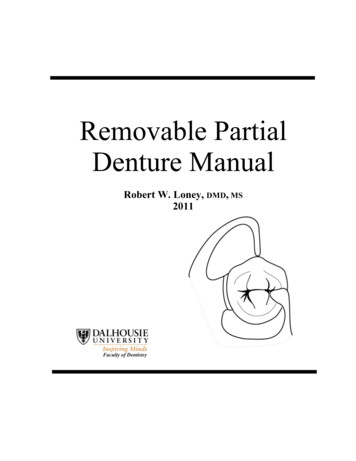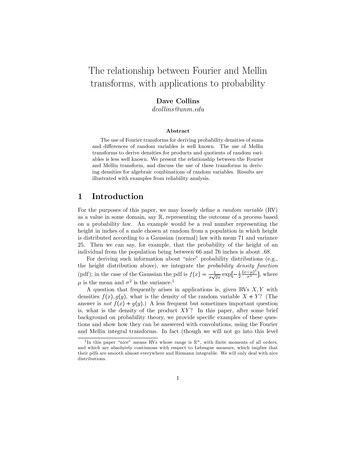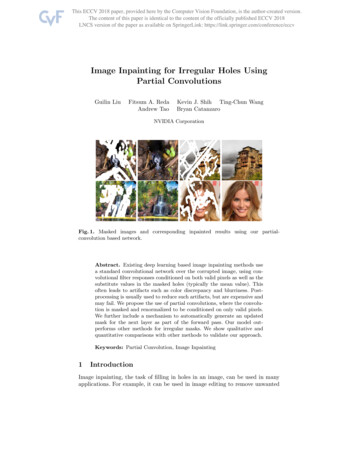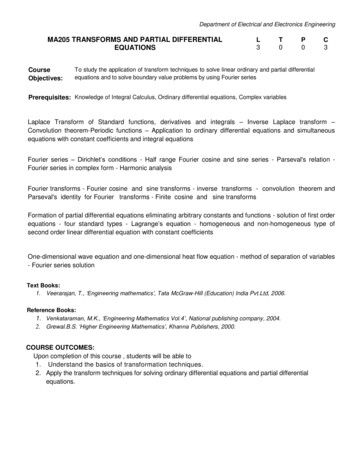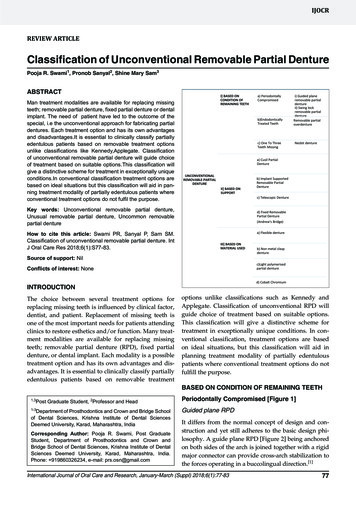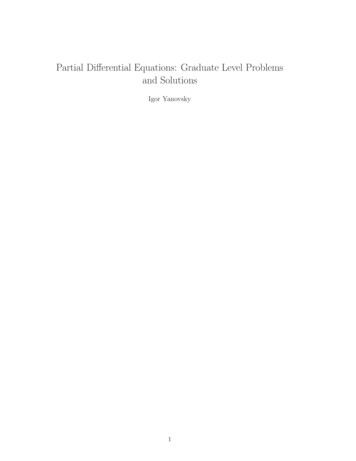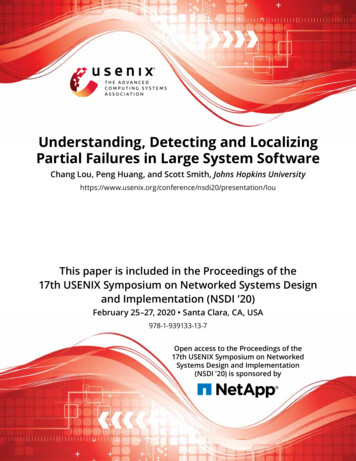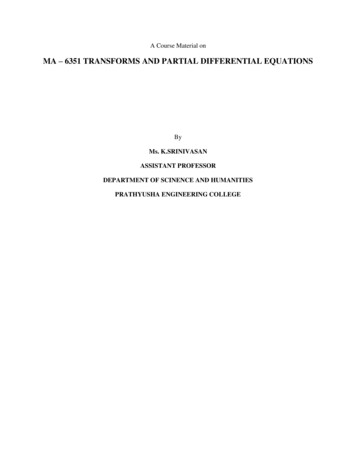
Transcription
A Course Material onMA – 6351 TRANSFORMS AND PARTIAL DIFFERENTIAL EQUATIONSByMs. K.SRINIVASANASSISTANT PROFESSORDEPARTMENT OF SCINENCE AND HUMANITIESPRATHYUSHA ENGINEERING COLLEGE
MA8353TRANSFORMS AND PARTIAL DIFFERENTIAL EQUATIONSLTPC3104OBJECTIVES:To introduce Fourier series analysis which is central to many applications in engineering apart from itsuse in solving boundary value problems?To acquaint the student with Fourier transform techniques used in wide variety of situations.To introduce the effective mathematical tools for the solutions of partial differential equationsthat model several physical processes and to develop Z transform techniques for discrete timeSystems.UNIT I PARTIAL DIFFERENTIAL EQUATIONS9 3Formation of partial differential equations – Singular integrals -- Solutions of standard types of first orderpartial differential equations - Lagrange’s linear equation -- Linear partial differential equations of secondand higher order with constant coefficients of both homogeneous and non-homogeneous types.UNIT II FOURIER SERIES9 3Dirichlet’s conditions – General Fourier series – Odd and even functions – Half range sine series –Halfrange cosine series – Complex form of Fourier series – Parseval’s identity – Harmonic analysis.UNIT III APPLICATIONS OF PARTIAL DIFFERENTIAL9 3Classification of PDE – Method of separation of variables - Solutions of one dimensional waveequation – One dimensional equation of heat conduction – Steady state solution of two dimensionalequation of heat conduction (excluding insulated edges).UNIT IV FOURIER TRANSFORMS9 3Statement of Fourier integral theorem – Fourier transform pair – Fourier sine andcosine transforms – Properties – Transforms of simple functions – Convolution theorem – Parseval’sidentity.UNIT V Z - TRANSFORMS AND DIFFERENCE EQUATIONS9 3Z- transforms - Elementary properties – Inverse Z - transform (using partial fraction and residues) –Convolution theorem - Formation of difference equations – Solution of difference equations using Z transform.TOTAL (L:45 T:15): 60 PERIODS.TEXT BOOKS:1. Veerarajan. T., "Transforms and Partial Differential Equations", Tata McGraw Hill Education Pvt.Ltd., New Delhi, Second reprint, 2012.2. Grewal. B.S., "Higher Engineering Mathematics", 42nd Edition, Khanna Publishers, Delhi, 2012.3. Narayanan.S., Manicavachagom Pillay.T.K and Ramanaiah.G "Advanced Mathematics forEngineering Students" Vol. II & III, S.Viswanathan Publishers Pvt. Ltd.1998.REFERENCES:1. Bali.N.P and Manish Goyal, "A Textbook of Engineering Mathematics", 7th Edition, LaxmiPublications Pvt Ltd, 2007.2. Ramana.B.V., "Higher Engineering Mathematics", Tata Mc Graw Hill Publishing Company Limited,NewDelhi, 2008.3. Glyn James, "Advanced Modern Engineering Mathematics", 3rd Edition, Pearson Education, 2007.4. Erwin Kreyszig, "Advanced Engineering Mathematics", 8th Edition, Wiley India, 2007.5. Ray Wylie. C and Barrett.L.C, "Advanced Engineering Mathematics" Tata Mc Graw Hill EducationPvt Ltd, Sixth Edition, New Delhi, 2012.6. Datta.K.B., "Mathematical Methods of Science and Engineering", Cengage Learning India Pvt Ltd,Delhi, 2013.
CONTENTSS.NO1.11.21.31.41.5TOPICSUNIT-I PARTIAL DIFFERENTIAL EQUATIONS1.6INTRODUCTIONFORMATION OF PARTIAL DIFFERNTIAL EQUATIONSSOLUTIONS OF PARTIAL DIFFERENTIAL EQUATIONSLAGRANGE’S LINEAR EQUATIONSPARTIAL DIFFERENTIAL EQUATIONS OF HIGHER ORDER WITH CONSTANTCO-EFFECIENTSNON-HOMOGENOUS LINEAR RIODIC FUNCTIONSEVEN AND ODD FUNCTIONSHALF RANGE SERIESPARSEVAL’S THEOREMCHANGE OF INTERVALHARMONIC ANALYSISCOMPLEX FORM OF FOURIER SERIESSUMMARYPAGE NO117232936UNIT-II FOURIER SERIES424254616869768083UNIT-III APPLICATIONS OF PARTIAL DIFFERENTILA EQUATIONSINTRODUCTIONSOLUTION OF WAVE EQUATIONSOLUTION OF THE HEAT EQUATIONSOLUTION OF LAPLACE EQUATIONS8787105120UNIT-IV FOURIER TRANSFORMS4.14.24.34.44.54.6INTRODUCTIONINTEGRAL TRANSFORMSFOURIER INTEGRAL THEOREMFOURIER TRANSFORMS AND ITS PROPERTIESCONVOLUTION THEOREM AND PARSEVAL’S THEOREMFOURIER SINE AND COSINE TRANSFORMS133133134137149154UNIT-V Z-TRANSFORMS AND DIFFERENCE EQUATIONSINTRODUCTIONLINEAR DIFFERENCE EQUATIONSZ-TRANSFORMS AND ITS PROPERTIESINVERSE Z-TRANSFORMSCONVOLUTION THEOREMAPPLICATIONS OF Z-TRANSFORMS TO DIFFERENCE EQUATIONSFORMATION OF DIFFERENCE EQUATIONSBIBLIOGRAPHY166167168183191193199200
UNIT– IPARTIAL DIFFERENTIAL EQUATIONSThis unit covers topics that explain the formation of partial differential equationsand the solutions of special types of partial differential equations.INTRODUCTIONA partial differential equation is one which involves one or more partialderivatives. The order of the highest derivative is called the order of the equation. Apartial differential equation contains more than one independent variable. But, here weshall consider partial differential equations involving one dependent variable „z‟ and onlytwo independent variables x and y so that z f(x,y). We shall denote z------- p, x z 2z 2z 2z----------- q, ---------- r, ---------- s, ------------ t. y x2 x y y2A partial differential equation is linear if it is of the first degree in the dependentvariable and its partial derivatives. If each term of such an equation contains either thedependent variable or one of its derivatives, the equation is said to be homogeneous,otherwise it is non homogeneous.Formation of Partial Differential EquationsPartial differential equations can be obtained by the elimination of arbitrary constants orby the elimination of arbitrary functions.By the elimination of arbitrary constantsLet us consider the function ( x, y, z, a, b ) 0 -------------- (1)where a & b are arbitrary constantsDifferentiating equation (1) partially w.r.t x & y, we get p x q y 0(2) 0(3) z zEliminating a and b from equations (1), (2) and (3), we get a partial differentialequation of the first order of the form f (x,y,z, p, q) 0
Example 1Eliminate the arbitrary constants a & b from z ax by abConsiderz ax by ab(1)Differentiating (1) partially w.r.t x & y, we get z ai.e, p a bi.e, q b(2) x z(3) yUsing (2) & (3) in (1), we getz px qy pqwhich is the required partial differential equation.Example 2Form the partial differential equation by eliminating the arbitrary constants a and bfromz ( x2 a2 ) ( y2 b2)Given z ( x2 a2 ) ( y2 b2)Differentiating (1) partially w.r.t x & y , we getp 2x (y2 b2 )q 2y (x a )Substituting the values of p and q in (1), we get4xyz pqwhich is the required partial differential equation.(1)
Example 3Find the partial differential equation of the family of spheres of radius one whose centrelie in the xy - plane.The equation of the sphere is given by( x – a )2 ( y- b) 2 z2 1(1)Differentiating (1) partially w.r.t x & y , we get2 (x-a ) 2 zp 2 ( y-b ) 2 zq 00From these equations we obtainx-a -zpy -b -zq(2)(3)Using (2) and (3) in (1), we getz2p2 z2q2 z2 1or z2 ( p2 q2 1) 1Example 4Eliminate the arbitrary constants a, b & c fromx2y2 2z2 2a 1 and form the partial differential equation.2bcThe given equation isx2y2 a2z2 b2 1c2(1)
Differentiating (1) partially w.r.t x & y, we get2x2zp 0a2c22y2zq 2b 02cTherefore we getxzp 2 0(2)2ayczq 0b2(3)c2Again differentiating (2) partially w.r.t „x‟, we set(1/a2 ) (1/ c2 ) ( zr p2 ) 0(4)Multiplying ( 4) by x, we getxp2xxz r a2 c2 0c2From (2) , we havezp c2p2 xxzr c2 0c2or -zp xzr p2x 0By the elimination of arbitrary functionsLet u and v be any two functions of x, y, z and Φ(u, v ) 0, where Φ is anarbitrary function. This relation can be expressed asu f(v)(1)
Differentiating (1) partially w.r.t x & y and eliminating the arbitraryfunctions from these relations, we get a partial differential equation of the first orderof the formf(x, y, z, p, q ) 0.Example 5Obtain the partial differential equation by eliminating „f „ from z ( x y ) f ( x 2 - y2 )Let us now consider the equationz (x y ) f(x2- y2)(1)Differentiating (1) partially w.r.t x & y , we getp ( x y ) f ' ( x2 - y2 ) . 2x f ( x2 - y2 )q ( x y ) f ' ( x2 - y2 ) . (-2y) f ( x2 - y2 )These equations can be written asp - f ( x2 - y2 ) ( x y ) f '( x2 - y2 ) . 2xq - f ( x2 - y2 ) ( x y ) f '( x2 - y2 ) .(-2y)Hence, we getp - f ( x2 - y2 )(2)(3)x -q - f ( x2 - y2 )i.e,i.e,ypy - yf( x2 - y2 ) -qx xf ( x2 - y2 )py qx ( x y ) f ( x2 - y2 )Therefore, we have by(1),py qx zExample 6Form the partial differential equation by eliminating the arbitrary function ffromz ey f (x y)Consider z ey f ( x y )( 1)Differentiating (1) partially w .r. t x & y, we getp ey f ' (x y)q ey f '(x y) f(x y). eyHence, we haveq p z
Example 7Form the PDE by eliminatingf & Φ from z f (x ay ) Φ ( x – ay)Consider z f (x ay ) Φ ( x – ay)(1)Differentiating (1) partially w.r.t x &y , we getp f '(x ay ) Φ' (x – ay)q f ' (x ay ) .a Φ' (x – ay) ( -a)(2)(3)Differentiating (2) & (3) again partially w.r.t x & y, we getr f "( x ay) Φ "( x – ay)t f "( x ay) .a2 Φ"( x – ay) (-a)2i.e,t a2 { f"( x ay) Φ"( x – ay)}ort a2rExercises:1.„b‟2.Form the partial differential equation by eliminating the arbitrary constants „a‟ &from the following equations.(i)z ax by(ii)x2 y2z2 1a2b2(iii)z ax by a2 b2(iv)ax2 by2 cz2 1(v)z a2x b2y abFind the PDE of the family of spheres of radius 1 having their centres lie on thexy plane{Hint: (x – a)2 (y – b)2 z2 1}3.Find the PDE of all spheres whose centre lie on the (i) z axis (ii) x-axis4.Form the partial differential equations by eliminating the arbitrary functions in thefollowing cases.(i)z f (x y)(ii)z f (x2 – y2)(iii)z f (x2 y2 z2)(iv) (xyz, x y z) 0
(v)(vi)(vii)(viii)(ix)(x)z x y f(xy)z xy f (x2 y2)z f xyzF (xy z2, x y z) 0z f (x iy) f (x – iy)z f(x3 2y) g(x3 – 2y)SOLUTIONS OF A PARTIAL DIFFERENTIAL EQUATIONA solution or integral of a partial differential equation is a relation connecting thedependent and the independent variables which satisfies the given differential equation. Apartial differential equation can result both from elimination of arbitrary constants andfrom elimination of arbitrary functions as explained in section 1.2. But, there is a basicdifference in the two forms of solutions.A solution containing as many arbitraryconstants as there are independent variables is called a complete integral. Here, the partialdifferential equations contain only two independent variables so that the completeintegral will include two constants.A solution obtained by giving particular values to thearbitrary constants in a complete integral is called a particular integral.Singular IntegralLet f (x,y,z,p,q) 0 -----------(1)be the partial differential equation whose complete integral is (x,y,z,a,b) 0 --------------- (2)where „a‟ and „b‟ are arbitrary constants.Differentiating (2) partially w.r.t. a and b, we obtain -------- 0----------- (3) a and--------- 0 -------------------------------------- (4) bThe eliminant of „a‟ and „b‟ from the equations (2), (3) and (4), when it exists, iscalled the singular integral of (1).
General IntegralIn the complete integral (2), put b F(a), we get (x,y,z,a, F(a) ) 0 ---------------------------------------- (5)Differentiating (2), partially w.r.t.a, we get ------- -------- F'(a) 0 -------------------------- (6) a bThe eliminant of „a‟ between (5) and (6), if it exists, is called the general integral of (1).SOLUTION OF STANDARD TYPES OF FIRST ORDER PARTIALDIFFERENTIAL EQUATIONS.The first order partial differential equation can be written asf(x,y,z, p,q) 0,where p z/ x and q z / y. In this section, we shall solve some standard formsof equations by special methods.Standard I : f (p,q) 0. i.e, equations containing p and q only.Suppose that z ax by c is a solution of the equation f(p,q) 0, where f (a,b) 0.Solving this for b, we get b F (a).Hence the complete integral is z ax F(a) y c ------------------------- (1)Now, the singular integral is obtained by eliminating a & c betweenz ax y F(a) c0 x y F'(a)0 1.The last equation being absurd, the singular integral does not exist in this case.To obtain the general integral, let us take c (a).
z ax F(a) y (a) ---------------------- (2)Then,Differentiating (2) partially w.r.t. a, we get0 x F'(a). y '(a) ------------------------ (3)Eliminating „a‟ between (2) and (3), we get the general integralExample 8Solve pq 2The given equation is of the form f (p,q) 0The solution is z ax by c, where ab 2.2Solving,b ---- --.aThe complete integral is2Z ax ------ y c ------------------------------(1)aDifferentiating (1) partially w.r.t „c‟, we get0 1,which is absurd. Hence, there is no singular integral.To find the general integral, put c (a) in (1), we get2Z ax ------- y (a)aDifferentiating partially w.r.t „a‟, we get20 x--------- y (a)a2Eliminating „a‟ between these equations gives the general integral.
Example 9Solve pq p q 0The given equation is of the form f (p,q) 0.The solution is z ax by c, where ab a b 0.Solving, we getb –a-------1 aaHence the complete Integral is z ax – ------1 ay c ------------------------ (1)Differentiating (1) partially w.r.t. „c‟, we get0 1.The above equation being absurd, there is no singular integral for the given partialdifferential equation.To find the general integral, put c (a) in (1), we haveaz ax – --------1 ay (a) ------------------------------------- (2)Differentiating (2) partially w.r.t a, we get110 x – -------- y (a) ------------------------------------- (3)(1 a)2Eliminating „a‟ between (2) and (3) gives the general integral.Example 10Solve p2 q2 npqThe solution of this equation is z ax by c, where a2 b2 nab.Solving, we getb an (n2 – 4)------------------
2Hence the complete integral isn n2 – 4z ax a -----------------2y c ------------------------ (1)Differentiating (1) partially w.r.t c, we get 0 1, which is absurd. Therefore, there is nosingular integral for the given equation.To find the general Integral, put C (a), we getz ax n n2 – 4a ------------------------- y (a)2Differentiating partially w.r.t „a‟, we haven n2 – 40 x ------------------2y (a)The eliminant of „a‟ between these equations gives the general integralStandard II : Equations of the form f (x,p,q) 0, f (y,p,q) 0 and f (z,p,q) 0.i.e, one of the variables x,y,z occurs explicitly.(i)Let us consider the equation f (x,p,q) 0.Since z is a function of x and y, we have z zdz ------- dx -------- dy x yordz pdx qdyAssume that q a.Then the given equation takes the form f (x, p,a ) 0Solving, we getTherefore,p (x,a).dz (x,a) dx a dy.Integrating, z (x,a) dx ay b which is a complete Integral.
(ii) Let us consider the equation f(y,p,q) 0.Assume that p a.Then the equation becomes f (y,a, q) 0Solving, we get q (y,a).Therefore, dz adx (y,a) dy.Integrating, z ax (y,a) dy b, which is a complete Integral.(iii) Let us consider the equation f(z, p, q) 0.Assume that q ap.Then the equation becomes f (z, p, ap) 0Solving, we get p (z,a). Hence dz (z,a) dx a (z, a) dy.dzie, ------------ dx ady. (z,a)Integrating,dz x ay b, which is a complete Integral. (z,a)Example 11Solve q xp p2Givenq xp p2 -------------- (1)This is of the form f (x,p,q) 0.Put q a in (1), we geta xp p2e, p2 xp – a 0.i.Therefore,-x (x2 4a)p -------------------2
– x x2 4az dx ay b2Integrating ,x2xx2–1 ---------z – ------ ------ (4a x ) a sin h ay b442 aThus,Example 12Solve q yp2This is of the form f (y,p,q) 0Then, put p a.Therfore, the given equation becomes q a2y.Since dz pdx qdy, we havedz adx a2y dya2y2Integrating, we get z ax --------- b2Example 13Solve 9 (p2z q2) 4This is of the form f (z,p,q) 0Then, putting q ap, the given equation becomes9 (p2z a2p2) 4Therefore,2p ---------3 ( z a2)and2aq ---------3 ( z a2)Since dz pdx qdy,
2dz -----3121---------- dx -------- a ----------- dy z a23 z a2Multiplying both sides by z a2, we get22 z a dz ------ dx ------ a dy , which on integration gives,332(z a2)3/222------------- ------ x -------- ay b.3/233(z a2)3/2 x ay b.orStandard III : f1(x,p) f2 (y,q). ie, equations in which ‘z’ is absent and the variablesareseparable.Let us assume as a trivial solution thatf(x,p) g(y,q) a (say).Solving for p and q, we get p F(x,a) and q G(y,a).But z zdz -------- dx ------- dy x yHence dz pdx qdy F(x,a) dx G(y,a) dyTherefore, z F(x,a) dx G(y,a) dy b , which is the complete integral of the givenequation containing two constants a and b. The singular and general integrals are found inthe usual way.Example 14Solve pq xyThe given equation can be written aspy----- ------ a (say)xq
Therefore,andp----- axy------ aqimpliesp axyimplies q ----aSince dz pdx qdy, we haveydz axdx ------ dy, which on integration gives.aax2y2z ------- -------- b22aExample 15Solve p2 q2 x2 y2The given equation can be written asp2 – x2 y2 – q2 a2 (say)andButp2 – x2 a2implies p (a2 x2)y2 – q2 a2implies q (y2 – a2)dz pdx qdyie, dz a2 x2 dx y2 – a2 dyIntegrating, we getxa2xya2y22–122z ---- x a ----- sinh----- ---- y – a – ----- cosh-1 --------- b22a22aStandard IV (Clairaut’s form)Equation of the type z px qy f (p,q) ------(1) is known as Clairaut‟s form.
Differentiating (1) partially w.r.t x and y, we getp a andq b.Therefore, the complete integral is given byz ax by f (a,b).Example 16Solve z px qy pqThe given equation is in Clairaut‟s form.Putting p a and q b, we havez ax by ab -- (1)which is the complete integral.To find the singular integral, differentiating (1) partially w.r.t a and b, we get0 x b0 y aTherefore we have, a -y and b -x.Substituting the values of a & b in (1), we getz -xy – xy xyorz xy 0, which is the singular integral.To get the general integral, put b (a) in (1).Then z ax (a)y a (a) --------------------------------------------- (2)Differentiating (2) partially w.r.t a, we have0 x '(a) y a '(a) (a) ------------------------------------ (3)Eliminating „a‟ between (2) and (3), we get the general integral.
Example 17Find the complete and singular solutions of z px qy 1 p2 q2The complete integral is given byz ax by 1 a2 b2 ------------------------------------------------- (1)To obtain the singular integral, differentiating (1) partially w.r.t a & b. Then,a0 x -------------------- 1 a2 b2b0 y -------------------- 1 a2 b2Therefore,–ax ------------------------------- (2) (1 a2 b2)–by ------------------------------- (3) (1 a2 b2)andSquaring (2) & (3) and adding, we geta2 b2x2 y2 -----------------1 a2 b2Now,i.e,11 – x – y ----------------1 a2 b211 a2 b2 ---------------1 – x2 – y222Therefore,1 (1 a b ) ------------------------------------ (4) 1 – x2 – y2Using (4) in (2) & (3), we get22
x – a 1 – x2 – y2y – b 1 – x2 – y2andHence,-xa ------------ 1–x2–y2and-yb --------------- 1–x2–y2Substituting the values of a & b in (1) , we get- x2y21z ------------- – -------------- -------------- 1–x2–y2 1–x2–y2 1–x2–y2which on simplification givesz 1 – x2 – y2orx2 y2 z2 1,which is the singular integral.ExercisesSolve the following Equations1. pq k2. p q pq3. p q x4. p y2q25. z p2 q26. p q x y7. p2z2 q2 18. z px qy - 2 pq9. {z – (px qy)}2 c2 p2 q210. z px qy p2q2EQUATIONS REDUCIBLE TO THE STANDARD FORMSSometimes, it is possible to have non – linear partial differential equations of thefirst order which do not belong to any of the four standard forms discussed earlier. Bychanging the variables suitably, we will reduce them into any one of the four standardforms.Type (i) : Equations of the form F(xm p, ynq) 0 (or) F (z, xmp, ynq) 0.Case(i) : If m 1 and n 1, then put x1-m X and y1-n Y.
z z X zNow, p ----- ------ . ------- -------- (1-m) x -m x X x X z zTherefore, x p ------ (1-m) (1 – m) P, where P ------ X X zSimilarly, ynq (1-n)Q, where Q ----- YHence, the given equation takes the form F(P,Q) 0 (or) F(z,P,Q) 0.Case(ii) : If m 1 and n 1, then put log x X and log y Y.m z z X z1Now, p ----- ------- . ------- ------- ----- x X x Xx zTherefore, xp -------- P. XSimilarly, yq Q.Example 18Solve x4p2 y2zq 2z2The given equation can be expressed as(x2p)2 (y2q)z 2z2Here m 2, n 2Put X x1-m x -1 and Y y 1-n y -1.We have xmp (1-m) P and ynq (1-n)Qi.e,x2p -P and y2q -Q.Hence the given equation becomesP2 – Qz 2z2 -------------------- (1)This equation is of the form f (z,P,Q) 0.Let us take Q aP.
Then equation (1) reduces toP2 – aPz 2z2a (a2 8)P --------------------- z2Hence,a (a2 8)andQ a ------------------- z2Since dz PdX QdY, we havea (a2 8)a (a2 8)dz ---------------- z dX a ------------------- z dY22i.e,dza (a2 8)------ ------------------ (dX a dY)z2Integrating, we geta a2 8log z ----------------- (X aY) b2Therefore,a (a2 8)log z ---------------21a---- ----- b which is the complete solution.xyExample 19Solve x2p2 y2q2 z2The given equation can be written as(xp)2 (yq)2 z2Here m 1, n 1.Put X log x and Y log y.
Then xp P and yq Q.Hence the given equation becomesP2 Q2 z2 -------------- (1)This equation is of the form F(z,P,Q) 0.Therefore, let us assume that Q aP.Now, equation (1) becomes,HenceandP2 a2 P2 z2zP ------- (1 a2)azQ ------- (1 a2)Since dz PdX QdY, we havezazdz ----------dX ---------- dY. (1 a2) (1 a2)dz2i.e, (1 a ) ------ dX a dY.zIntegrating, we get (1 a2) log z X aY b.Therefore, (1 a2) log z logx alogy b, which is the complete solution.Type (ii) : Equations of the form F(zkp, zkq) 0 (or) F(x, zkp) G(y,zkq).Case (i) : If k -1, put Z zk 1, Z Z z zNow ------- -------- ------- (k 1)zk. ------- (k 1) zkp. x z x x1 ZTherefore, z p ----- ------k 1 xk
1 ZSimilarly, z q ------- -----k 1 ykCase (ii) : If k -1, put Z log z. Z Z z1Now, ------- -------- ------- ------ p x z xz Z1Similarly,----- ----- q. yzExample 20Solve z4q2 – z2p 1The given equation can also be written as(z2q)2 – (z2p) 1Here k 2. Putting Z z k 1 z3, we get1 ZZ p ------ -----k 1 xk1 Zi.e, Z p ------ -----3 x2and1 ZZ q ------ -----k 1 yand1 ZZ q ------ -----3 yk2Hence the given equation reduces toQ 2P------ ------ 133i.e,Q2 – 3P – 9 0,which is of the form F(P,Q) 0.Hence its solution is Z ax by c, where b2 – 3a – 9 0.Solving for b, b (3a 9)
Hence the complete solution isZ ax (3a 9) . y corz3 ax (3a 9) y cExercisesSolve the following equations.1. x2p2 y2p2 z22. z2 (p2 q2) x2 y23. z2 (p2x2 q2) 14. 2x4p2 – yzq – 3z2 05. p2 x2y2q2 x2 z26. x2p y2q z27. x2/p y2/q z8. z2 (p2 – q2) 19. z2 (p2/x2 q2/y2) 110. p2x q2y z.Lagrange’s Linear EquationEquations of the form Pp Qq R(1), where P, Q and R arefunctions of x, y, z, are known as Lagrange‟s equations and are linear in „p‟ and „q‟.Tosolve this equation, let us consider the equations u a and v b, where a, b are arbitraryconstants and u, v are functions of x, y, z.Since „u ‟ is a constant, we have du 0 ----------- (2).But „u‟ as a function of x, y, z, udu udx xComparing (2) and (3), we have udx xSimilarly, v ydz z u udy y z v vdx x udy dy y zdz 0(3)dz 0(4)
By cross-multiplication, we havedxdydz u v u v u v z u v u v- y y z x z u v z x y x x y(or)dxdy Pdz (5)QREquations (5) represent a pair of simultaneous equations which are of the firstorder and of first degree.Therefore, the two solutions of (5) are u a and v b. Thus, ( u, v ) 0 is the required solution of (1).Note :To solve the Lagrange‟s equation,we have to form the subsidiary or auxiliaryequationsdxdydz PQRwhich can be solved either by the method of grouping or by the method ofmultipliers.Example 21Find the general solution of px qy z.Here, the subsidiary equations aredxdy xxTaking the first two ratios ,ydz ydxIntegrating, log x log y log c1z dy
yorx c1 yi.e,c1 x / yFrom the last two ratios,zdy dzIntegrating, log y log z log c2ory c2 zi. e,c2 y / zHence the required general solution isΦ( x/y, y/z) 0, where Φ is arbitraryExample 22Solve p tan x q tan y tan zThe subsidiary equations aredxdydz tanx tanytanzTaking the first two ratios ,ie,dydx tanxtanycotx dx coty dyIntegrating, log sinx log siny log c1ie, sinx c1 sinyTherefore,c1 sinx / sinySimilarly, from the last two ratios, we getsiny c2 sinzi. e,c2 siny / sinzHence the general solution is
sinxΦsiny 0, where Φ is arbitrary.,sinysinzExample 23Solve (y-z) p (z-x) q x-yHere the subsidiary equations aredxdy y-zdz x –yz- xUsing multipliers 1,1,1,dx dy dzeach ratio 0Therefore, dx dy dz 0.Integrating, x y z c1(1)Again using multipliers x, y and z,xdx ydy zdzeach ratio 0Therefore,Integrating,orxdx ydy zdz 0.x2/2 y2/2 z2/2 constantx2 y2 z2 c2(2)Hence from (1) and (2), the general solution isΦ ( x y z, x2 y2 z2) 0Example 24Find the general solution of (mz - ny) p (nx- lz)q ly - mx.
Here the subsidiary equations aredxdydz mz- ny nx - lzly - mxUsing the multipliers x, y and z, we getxdx ydy zdzeach fraction 0 xdx ydy zdz 0, which on integration givesx2/2 y2/2 z2/2 constantx2 y2 z2 c1or(1)Again using the multipliers l, m and n, we haveldx mdy ndzeach fraction 0 ldx mdy ndz 0, which on integration giveslx my nz c2(2)Hence, the required general solution isΦ(x2 y2 z2 , lx my nz ) 0Example 25Solve (x2 - y2 - z2 ) p 2xy q 2xz.The subsidiary equations aredxdydz x2-y2-z2 2xz2xyTaking the last two ratios,dxdz 2xy2xz
2xy2xzdydzie, yIntegrating, we getzlog y log z log c1or y c1zi.e, c1 y/z(1)Using multipliers x, y and z, we getxdx y dy zdzxdx y dy zdz each fraction x ( x2 y2 z2 )x (x2-y2-z2 ) 2xy2 2xz2Comparing with the last ratio, we getxdx y dy zdzdz x ( x2 y2 z2 )2xz2xdx 2ydy 2zdzi.e,dz x2 y2 z2Integrating,zlog ( x2 y2 z2 ) log z log c2x2 y2 z2or c2 zx2 y2 z2i.e,c2 (2)zFrom (1) and (2), the general solution is Φ(c1 , c2) 0.x2 y2 z2i.e,Φ (y/z) , 0z
ExercisesSolve the following equations1. px2 qy2 z22. pyz qzx xy3. xp – yq y2 – x24. y2zp x2zq y2x5. z (x – y) px2 – qy26. (a – x) p (b – y) q c – z7. (y2z p) /x xzq y28. (y2 z2) p – xyq xz 09. x2p y2q (x y) z10. p – q log (x y)11. (xz yz)p (xz – yz)q x2 y212. (y – z)p – (2x y)q 2x zPARTIAL DIFFERENTIAL EQUATIONS OF HIGHER ORDER WITHCONSTANT COEFFICIENTS.Homogeneous Linear Equations with constant Coefficients.A homogeneous linear partial differential equation of the nth order is of the form nz nz nzc0 ------ c1 ----------- . . . . . . cn -------- F (x,y) ------------------- (1) xn xn-1 y ynwhere c0, c1,---------, cn are constants and F is a function of „x‟ and „y‟. It ishomogeneous because all its terms contain derivatives of the same order.Equation (1) can be expressed asor(c0Dn c1Dn-1 D' . cn D'n ) z F (x,y)f (D,D') z F (x,y)------------------- (2),
where, ----- D and ------- D' . x yAs in the case of ordinary linear equations with constant coefficients the completesolution of (1) consists of two parts, namely, the complementary function and theparticular integral.The complementary function is the complete solution of f (D,D') z 0 ------ (3),which must contain n arbitrary functions as the degree of the polynomial f(D,D'). Theparticular integral is the particular solution of equation (2).Finding the complementary functionLet us now consider the equation f(D,D') z F (x,y)The auxiliary equation of (3) is obtained by replacing D by m and D' by 1.i.e, c0 mn c1 mn-1 . cn 0 ------------ (4)Solving equation (4) for „m‟, we get „n‟ roots. Depending upon the nature of the roots,the Complementary function is written as given below:Roots of the auxiliaryNature of theequationrootsm1,m2,m3 . ,mndistinct rootsm1 m2 m, m3 ,m4, .,mn two equal rootsm1 m2 . mn mall equal rootsComplementary function(C.F)f1 (y m1x) f2(y m2x) . fn(y mnx).f1(y m1x) xf2(y m1x) f3(y m3x) . fn(y mnx).f1(y mx) xf2(y mx) x2f3(y mx) . xn-1 fn (y mx)Finding the particular IntegralConsider the equation f(D,D') z F (x,y).1Now, the P.I is given by ---------- F (x,y)f(D,D')Case (i) : When F(x,y) eax by1P.I ------------eax byf (D,D')Replacing D by „a‟ and D' by „b‟, we have1P.I ----------- eax by,where f (a,b) 0.
f (a,b)Case (ii) : When F(x,y) sin(ax by) (or) cos (ax by)1P.I ----------------- sin (ax by) or cos (ax by)f(D2,DD',D'2)Replacing D2 -a2, DD' 2 -ab and D' -b2, we get1P.I ----------------- sin (ax by) or cos (ax by) , where f(-a2, - ab, -b2) 0. f(a2, - ab, -b2)Case (iii) : When F(x,y) xm yn,1P.I ---------- xm yn [f (D, D')]-1 xm ynf(D,D')Expand [f (D,D')]-1 in ascending powers of D or D' and operate on xm yn term by term.Case (iv) : When F(x,y) is any function of x and y.1P.I ----------- F (x,y).f (D,D')1Resolve----------- into partial fractions considering f (D,D') as a function of D alone.f (D,D')Then operate each partial fraction on F(x,y) in such a way that1--------- F (x,y) F(x,c-mx) dx ,D–mD'where c is replaced by y mx after integrationExample 26Solve(D3 – 3D2D' 4D'3) z ex 2yThe auxillary equation is
To acquaint the student with Fourier transform techniques used in wide variety of situations. . Inverse Z - transform (using partial fraction and residues) - Convolution theorem - Formation of difference equations - Solution of difference equations using Z - transform. TOTAL (L:45 T:15): 60 PERIODS. TEXT BOOKS: 1. Veerarajan.
